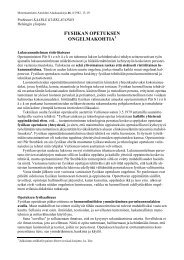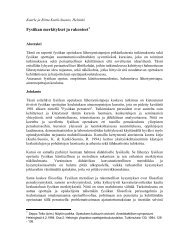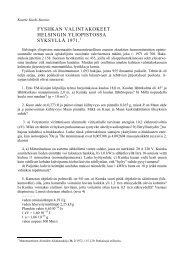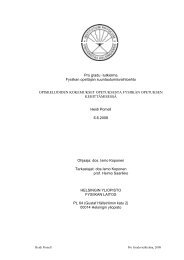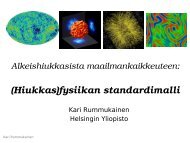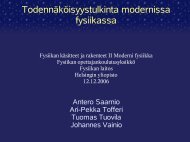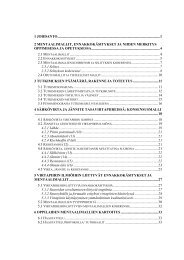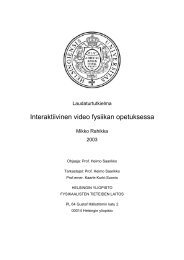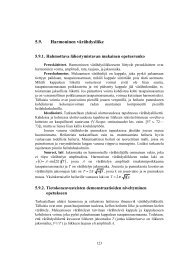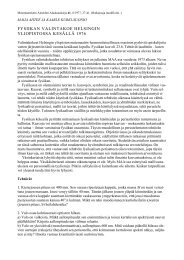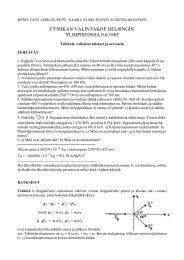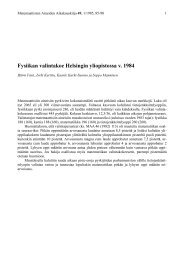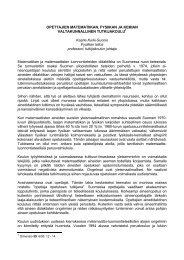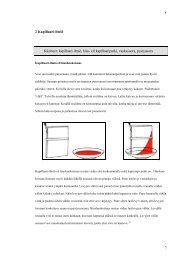Presentation
Presentation
Presentation
Create successful ePaper yourself
Turn your PDF publications into a flip-book with our unique Google optimized e-Paper software.
A multi-level perspective of science teaching<br />
and the role of video based analysis<br />
Hans E. Fischer<br />
University Duisburg-Essen<br />
Germany<br />
Hans.Fischer@uni-due.de
Outline<br />
1. Modeling (science) instruction<br />
2. The role of video based analysis<br />
3. Recent results of video based research<br />
4. Further aims<br />
0 1 2 3 4
Conditions for science instruction<br />
0 1 2 3 4<br />
In general: Discipline, organization of lessons,<br />
pacing, monitoring …<br />
Specific structure of subject matter<br />
(logic of content, scientific literacy, NOS, SI)<br />
Science specific teaching processes<br />
(experimental work, professional knowledge)<br />
Science specific learning processes<br />
(pre-knowledge, problem solving, conceptual<br />
development)<br />
System conditions<br />
(specific sequences, science or subjects, curricula)<br />
Quality of instruction
Paradigms of Quality of Instruction<br />
Behaviorism<br />
Mandl & Hron, Carroll (from 1970): Quality was operationalized as<br />
time on task<br />
Direct instruction, cognitivism<br />
Mayer, Rosenshine, Sweller (from 1980): information processing,<br />
cognitive structure, cognitive load<br />
Teacher personality and styles of instruction,<br />
subjective Theories<br />
Dann, Wahl, Pallasch, Shulman (from 1980): Interaction analysis,<br />
teacher knowledge<br />
Process-product-paradigm<br />
Helmke & Weinert (from 1990): Quality as model of instruction<br />
connected with students‘ performance<br />
0 1 2 3 4
Paradigms of Quality of Instruction<br />
Process-mediation-product-paradigm<br />
Baumert & Köller, Leutner (from 1990): processes of<br />
cognitive assimilation, strategies of learning and self<br />
regulated learning<br />
Offer-mediation-use-paradigm<br />
Klieme (from 2000): student as co-producer of his/her<br />
own knowledge, vertical fit of cognitive concepts,<br />
cognitive activation<br />
0 1 2 3 4
Important for quality of Instruction<br />
Time on task<br />
Information processing, cognitive structure,<br />
cognitive load<br />
Classroom interaction, teacher knowledge<br />
Students‘ performance<br />
Cognitive assimilation, strategies of learning<br />
and self regulated learning<br />
Student as co-producer of knowledge, vertical<br />
fit of cognitive concepts, cognitive activation
Offer-mediation-use-paradigm<br />
Family<br />
Content of the<br />
family<br />
environement<br />
Parents as:<br />
Pedagoges<br />
Example<br />
Model of<br />
language<br />
Teacher<br />
Instruction<br />
(offer)<br />
Quality of<br />
instruction<br />
Teachers‘<br />
personality<br />
and expertise<br />
Teaching and<br />
learning material<br />
Individual pre-conditions<br />
Mediations-<br />
Processes<br />
Perception and<br />
interpretation<br />
of teacher and<br />
students<br />
School- and class context<br />
Subject and curriculum context<br />
Learning<br />
activity<br />
(use)<br />
Learning<br />
processes during<br />
instruction<br />
Out of school<br />
activities<br />
Effect<br />
(return)<br />
Subject specific:<br />
Knowkedge<br />
Literacy<br />
Abilities<br />
Competencies<br />
Others:<br />
Key competencies<br />
Socialisation<br />
0 1 2 3 4<br />
Klieme
Offer-mediation-use-paradigm<br />
Family<br />
Content of the<br />
family<br />
environement<br />
Parents as:<br />
Pedagoges<br />
Example<br />
Model of<br />
language<br />
Teacher<br />
Instruction<br />
(offer)<br />
Quality of<br />
instruction<br />
Teachers‘<br />
personality<br />
and expertise<br />
Teaching and<br />
learning material<br />
Individual pre-conditions<br />
Mediations-<br />
Processes<br />
Perception and<br />
interpretation<br />
of teacher and<br />
students<br />
School- and class context<br />
Subject and curriculum context<br />
Learning<br />
activity<br />
(use)<br />
Learning<br />
processes during<br />
instruction<br />
Out of school<br />
activities<br />
Effect<br />
(return)<br />
Subject specific:<br />
Knowkedge<br />
Literacy<br />
Abilities<br />
Competencies<br />
Others:<br />
Key competencies<br />
Socialisation<br />
0 1 2 3 4<br />
Klieme
Research on instruction<br />
Teacher<br />
Professional<br />
knowledge<br />
Practical experience<br />
Background<br />
Instruction<br />
Pre-knowledge<br />
Motivation/Interest<br />
Background<br />
(social/ cognitiv)<br />
Students<br />
School/family<br />
environment<br />
Planning and<br />
performing<br />
Offer<br />
Mediation<br />
Use<br />
Experience<br />
Learning processes<br />
Practical<br />
experience<br />
Critical reflection<br />
Further education<br />
Performance<br />
Expectation<br />
Motivation/interest<br />
0 1 2 3 4
TIMSS, PISA<br />
Teacher<br />
Professional<br />
knowledge<br />
Practical experience<br />
Background<br />
Instruction<br />
School/family<br />
environment<br />
Planning and<br />
performing<br />
Practical<br />
experience<br />
Critical reflection<br />
Further education<br />
Pre-knowledge<br />
Motivation/Interest<br />
Background<br />
(social/cognitiv)<br />
Students<br />
Experience<br />
Learning processes<br />
Performance<br />
Expectation<br />
Motivation/interest<br />
01 2 3 4
TIMSS-Video, TIMSS-R<br />
Teacher<br />
Professional<br />
knowledge<br />
Practical experience<br />
Background<br />
Instruction<br />
School/family<br />
environment<br />
Planning and<br />
performing<br />
Practical<br />
experience<br />
Critical reflection<br />
Further education<br />
Pre-knowledge<br />
Motivation/Interest<br />
Background<br />
(social/cognitiv)<br />
Students<br />
Experience<br />
Learning processes<br />
Performance<br />
Expectation<br />
Motivation/interest<br />
01 2 3 4
Duit, Fischer, Klieme, Labudde, IPN,<br />
nwu<br />
Teacher<br />
Professional<br />
knowledge<br />
Practical experience<br />
Background<br />
Instruction<br />
School/family<br />
environment<br />
Planning and<br />
performing<br />
Practical<br />
experience<br />
Critical reflection<br />
Further education<br />
Pre-knowledge<br />
Motivation/Interest<br />
Background<br />
(social/cognitiv)<br />
Students<br />
Experience<br />
Learning processes<br />
Performance<br />
Expectation<br />
Motivation/interest<br />
01 2 3 4
Variables of instruction<br />
Teacher<br />
Cognition<br />
•PK<br />
•PCK<br />
•CK<br />
Attitudes<br />
• Motivation/Interest<br />
•Personality<br />
• Individual concepts<br />
Instruction<br />
Students<br />
Cognition<br />
• Knowledge, competencies<br />
• Learning processes<br />
• Behaviour<br />
Attitudes<br />
• Self-Efficacy<br />
• Motivation/Interest<br />
• Intelligence/Aptitude<br />
01 2 3 4
Including Instruction<br />
Surface structure (Duit, Fischer, Klieme,<br />
Labudde, Prenzel/Seidel, Reusser …)<br />
Culture specific patterns, no correlation with performance<br />
Deep structure (Duit, Fischer, Klieme, Labudde,<br />
Sumfleth, Tiberghien, Viiri …)<br />
Rating of quality of instruction<br />
Level of teachers‘ offer<br />
Level of cognitive activation of students<br />
Structure of subject matter<br />
Communication structure, argumentation<br />
01 2 3 4
Cognitive activation<br />
Learning processes<br />
Argumentation
Variables of instruction<br />
Teacher<br />
Cognition<br />
•PK<br />
•PCK<br />
•CK<br />
Attitudes<br />
• Motivation/Interest<br />
•Personality<br />
• Individual concepts<br />
Instruction<br />
Teaching and learning aims, intentions of the teacher<br />
lesson design and teaching methods<br />
Teacher’s behaviour, action, media<br />
Teacher-student interaction<br />
Students’ behaviour, action, media<br />
Content related operations, development of meaning<br />
learning paths, cognitive activation<br />
Students<br />
Cognition<br />
• Knowledge, competencies<br />
• Learning processes<br />
• Behaviour<br />
Attitudes<br />
• Self-Efficacy<br />
• Motivation/Interest<br />
• Intelligence/Aptitude<br />
01 2 3 4
Variables of instruction<br />
Teacher<br />
Instruction<br />
Students<br />
Cognition<br />
•PK<br />
•PCK<br />
•CK<br />
Teaching and learning aims, intentions of the teacher<br />
lesson design and teaching methods<br />
Teacher’s behaviour, action, media<br />
Teacher-student interaction<br />
Students’ behaviour, action, media<br />
Content related operations, development of meaning<br />
learning paths, cognitive activation<br />
Cognition<br />
• Knowledge, competencies<br />
• Learning processes<br />
• Behaviour<br />
Offer<br />
Attitudes<br />
• Motivation/Interest<br />
•Personality<br />
Mediation<br />
Use<br />
• Individual concepts<br />
Attitudes<br />
• Self-Efficacy<br />
• Motivation/Interest<br />
• Intelligence/Aptitude<br />
01 2 3 4
Methods
Surface and deep structure of instruction<br />
Surface Structure (low inferent coding)<br />
Teacher‘s behaviour, actions, media<br />
Students‘ behaviour, actions, media<br />
Teacher-student interactions<br />
…<br />
Deep Structure (high inferent coding)<br />
Teacher‘s aims and intentions<br />
Teacher‘s instructional design and methods<br />
Students‘ content related activities (cognitive activation)<br />
Students‘ learning path<br />
Interaction among students-teachers and students-students<br />
Structure of classroom talk<br />
…<br />
01 2 3 4
Developing a coding procedure<br />
1. Knowing the theoretical basis<br />
2. Developing a research question<br />
3. Producing data<br />
Video recording, Data compression, data<br />
segmentation, on-line or/and transcripts, …<br />
4. Applying the constructs of the model<br />
a. Determination of categories<br />
b. Determination of indicators<br />
• As clear, precise and extensive as possible<br />
• On the intended level of observation
Developing a coding procedure<br />
5. Modeling the transfer from categories to<br />
indicators<br />
− First order coding manual containing rules,<br />
categories, indicators and examples<br />
6. Testing the coding procedure<br />
−<br />
−<br />
−<br />
−<br />
Estimation of reliability<br />
Discussing problematic coding<br />
Revising the coding manual<br />
Until the coding procedure works reliable<br />
(or until you have to be satisfied because of the<br />
timetable or lacking of money)
Developing a coding procedure<br />
7. Application of the coding procedure to the<br />
video-recordings of interest<br />
8. Validity check by correlating external criteria<br />
if possible<br />
01 2 3 4
Example of a Coding Manual<br />
Category/Value Definition Description/Indicators Examples Dissociation<br />
No Instruction/<br />
Interruption<br />
Pre-Instruction<br />
Instruction<br />
01 2 3 4<br />
Refers to sequences in<br />
which no instruction<br />
takes place.<br />
Instruction already<br />
took place before and<br />
continued later.<br />
All intervals are coded<br />
in which instruction<br />
does not yet take<br />
place. The amount of<br />
pre-instruction intervals<br />
is an indicator for<br />
how much time was<br />
actually used for<br />
instruction.<br />
All intervals are coded<br />
in which instruction<br />
takes place. The<br />
amount of coded<br />
intervals is an indicator<br />
for how much time was<br />
actually used for<br />
instruction (time on<br />
task).<br />
The Interruption<br />
usually is marked by<br />
non-teaching and nonlearning<br />
activity.<br />
Typically such<br />
Interruptions take<br />
longer than a coding<br />
interval.<br />
Teacher did not yet<br />
start with instruction.<br />
At the most teacher<br />
and students prepare<br />
for instruction.<br />
No specific description:<br />
Instruction takes<br />
place.<br />
Important: All<br />
additional coding<br />
refers only to intervals<br />
coded as instruction.<br />
External event or<br />
disruption like announcements<br />
or door<br />
knocking. Teacher<br />
leaves class-room,<br />
students remain without<br />
instructions.<br />
Clarification of formal<br />
or organizational<br />
matter.<br />
Students arrive at the<br />
classroom after the<br />
bell, unpack their<br />
books, wait for the<br />
teacher.<br />
Teacher indicating the<br />
beginning of instruction:<br />
„Lets start now“.<br />
Students stand up at<br />
the beginning of the<br />
lesson.<br />
Noise or disciplinary<br />
problems do not<br />
generally count as<br />
interruption; the<br />
action must be<br />
different from what<br />
usually happens<br />
during instruction.<br />
Separation from<br />
Instruction, Pre-<br />
Instruction is<br />
coded, until the<br />
teacher starts<br />
instruction.<br />
Mind connection<br />
with pre- and postinstruction.<br />
Instruction only<br />
takes place one<br />
time and is embraced<br />
by pre- and<br />
post-instruction<br />
phases.<br />
Georg Trendel, Rainer Wackermann, nwu-essen
Example of a Coding Manual<br />
Category/Value Definition Description/Indicators Examples Dissociation<br />
Instruction<br />
All intervals<br />
are coded in<br />
which<br />
instruction<br />
takes place.<br />
The amount of<br />
coded intervals<br />
is an indicator<br />
for time on<br />
task.<br />
No specific<br />
description:<br />
Instruction<br />
takes place.<br />
Important: All<br />
additional<br />
coding refers<br />
only to<br />
intervals coded<br />
as instruction.<br />
Teacher<br />
indicating the<br />
beginning of<br />
instruction:<br />
„Lets start<br />
now“.<br />
Students stand<br />
up at the<br />
beginning of<br />
the lesson.<br />
Mind<br />
connection<br />
with preand<br />
postinstruction.<br />
Instruction<br />
only takes<br />
place one<br />
time and is<br />
embraced by<br />
pre- and<br />
postinstruction<br />
phases.<br />
01 2 3 4<br />
Georg Trendel, Rainer Wackermann, nwu-essen
Results<br />
01 2 3 4
Results of Large Scale Assessments<br />
01 2 3 4<br />
Performance & culture (TIMSS/PISA):<br />
Competences are distributed country specific<br />
Strong influences from out of school (e.g. social<br />
background)<br />
Reference to Instruction (TIMSS-Video study,<br />
COAKTIV)<br />
„Scripts“ are culture specific<br />
Structure of lessons is dependent on conceptions of the<br />
teacher<br />
PCK and CK of the teachers are very strong variables to<br />
predict students‘ performance (mathematics/PISA)<br />
Not clarified:<br />
Are specific scripts responsible for specific competences ?<br />
How does PCK and CK influence instruction?
Expectation<br />
Video analysis should track the effect from<br />
teachers’ professional knowledge and beliefs –<br />
action during the lessons – students’<br />
performance, knowledge and beliefs<br />
Video analysis as methodology to close the gap<br />
between teachers’ knowledge, students’<br />
assessment and quality of instruction<br />
01 2 3 4
Descriptive Analysis (coding)<br />
45,00<br />
Surface structure: modes of interaction<br />
0,00<br />
Mean period of time per lesson [min]<br />
40,00<br />
35,00<br />
30,00<br />
25,00<br />
20,00<br />
7,25<br />
5,18<br />
2,33 0,80<br />
1,43<br />
1,52<br />
16,69<br />
2,78<br />
1,63<br />
8,84<br />
1,98<br />
2,61<br />
12,57<br />
0,14<br />
2,27<br />
5,05<br />
0,63<br />
35,63<br />
0,25<br />
3,25<br />
0,55<br />
34,55<br />
15,00<br />
28,45 29,36<br />
26,68 26,34<br />
10,00<br />
5,00<br />
0,00<br />
18,13<br />
groupwork<br />
seatwork<br />
transition<br />
classroom discourse<br />
cross section course A course B course C course D course E course F<br />
01 2 3 4<br />
Reyer & Fischer, 2004
Descriptive Analysis (coding)<br />
Goals of the lessons<br />
Learning by experience<br />
18,54 min<br />
Concept development<br />
13,05 min<br />
Diverse<br />
6,77 min<br />
Top down<br />
4,45 min<br />
Reproduction<br />
4,40 min<br />
Activation/ performance<br />
control<br />
Problem solving<br />
4,24 min<br />
3,44 min<br />
Routine work<br />
1,57 min<br />
Discipline<br />
0,79 min<br />
Conceptual change<br />
0,42 min<br />
No interpretation<br />
0,05 min<br />
mean per lesson [min]<br />
01 2 3 4<br />
Reyer & Fischer, 2004
Conclusions Surface Analysis<br />
Two types of lessons<br />
Student oriented teaching including experimental work<br />
(short and indiscriminate tasks, experiments in groups)<br />
Teacher centered classroom discussions, demonstrating<br />
experiments (mostly short answers of the students)<br />
Rarely students’ lectures and home work<br />
No correlation between surface structure and<br />
TIMSS-test results (TIMSS-Video, TIMSS-R, nwu)<br />
Correlation between surface structure and<br />
motivation (TIMSS-R)<br />
01 2 3 4
Conclusions Deep Structure<br />
Fact, action and apply oriented<br />
Factual knowledge is partly worked out by students’<br />
guessing and teachers’ confirming the guessed word as<br />
being correct<br />
Action is planned in advance as step to solve a task<br />
(also experimental)<br />
Experience and concept development is applied<br />
incompletely<br />
Problem solving and conceptual change is applied very<br />
rarely<br />
01 2 3 4
Results<br />
Teacher level<br />
01 2 3 4
COAKTIV<br />
(Baumert, Blum, Mathematik)<br />
Teacher<br />
Professional<br />
knowledge<br />
Experience<br />
Background<br />
School background<br />
Lesson planning & -<br />
performing<br />
Practical<br />
experience<br />
Critical reflection<br />
Further education<br />
Instruction<br />
Pre-knowledge<br />
Motivation/interest<br />
Background<br />
(social/cognitiv)<br />
Students<br />
Lesson experiences<br />
Learning processes<br />
Performance<br />
Expectation<br />
Motivation/interest<br />
01 2 3 4
Intervention<br />
Training<br />
(effects)<br />
Teacher beliefs and ideas<br />
(effects)<br />
Interaction during lessons<br />
(teacher and students)<br />
(effects)<br />
Rainer Wackermann<br />
nwu<br />
Students perception,<br />
-emotion and<br />
performance<br />
01 2 3 4
Content of the training<br />
Types of teaching aims (Oser)<br />
Learning through experience<br />
Conceptual change<br />
Problem solving<br />
Conceptual development<br />
Training<br />
Hypertext learning (top down)<br />
Motility<br />
Reproduction<br />
activation/control of learning processes and<br />
performance<br />
Discipline<br />
01 2 3 4
Conclusion<br />
Teacher training was successful on all levels<br />
and for all teachers and classes<br />
Sub-group of teachers performed even better<br />
than the average<br />
Basic models are an effective strategy for<br />
teaching physics<br />
01 2 3 4
Results<br />
Lesson level<br />
01 2 3 4
Linking of content during lessons<br />
Analysis of biology, chemistry and physics<br />
lessons<br />
Questions<br />
In which way teachers are going to link content?<br />
On which level students use the offered oportunities<br />
to learn?<br />
Is there a correlation between the level of teachers‘<br />
offer and students‘ test results?<br />
01 2 3 4
Results biology<br />
Positive Effects of linkage regarding<br />
- test results<br />
- interest<br />
- willingness to make efforts<br />
Julia Wadouh<br />
Birgit Neuhaus<br />
Angela Sandmann<br />
01 2 3 4
Results chemistry<br />
Ina Glemnitz<br />
Elke Sumfleth<br />
Correlation between level of teachers offer and<br />
linking level of students‘ answers<br />
Correlation between linking level of students‘<br />
answers and the structure of their knowledge<br />
More than 70% of students‘ response were on a<br />
low level of linkage<br />
01 2 3 4
Results physics<br />
Correlation between linking level of teachers<br />
offer (difficulty) and linking level of students‘<br />
answers<br />
But: teachers tend to expect too much<br />
And: Students of high ranking teachers don‘t show<br />
better test results<br />
Anna Lau<br />
Knut Neumann<br />
Hans E. Fischer<br />
Conclusions: The difficulty (level of linkage)<br />
should be better adapted to students‘ abilities<br />
01 2 3 4
New research question<br />
Anna Lau<br />
Knut Neumann<br />
Alexander Kauertz<br />
Hans E. Fischer<br />
Elke Sumfleth<br />
Which variable is decisive for predicting students<br />
learning outcomes at school, verticale linkage or<br />
fit between level of teachers’ offer and level of<br />
students’ answer?<br />
01 2 3 4
Difficulty characteristics of tasks<br />
measuring competence in physics<br />
Conceptual and integrated thinking<br />
should lead to more complex answers<br />
Describing complexity by variing tasks accordingly<br />
Complexity as a measure to predict the difficulty of<br />
Structuring physics content by means of big<br />
ideas (basic concepts)<br />
Are German standards for physics able to structure physics<br />
content for middle school teaching?<br />
Is it possible to vary those structures using tasks?<br />
Are those tasks a measure of difficulties?<br />
Alexander Kauertz<br />
Hans E. Fischer<br />
01 2 3 4
Results<br />
Complexity correlates<br />
with diffulty<br />
Different basic<br />
concepts lead to<br />
different diffuculties<br />
The results are basis<br />
for a competence<br />
model which can<br />
predict students<br />
abilities
New research question<br />
Hendrik Notarp<br />
Alexander Kauertz<br />
Knut Neumann<br />
Hans E. Fischer<br />
Developing and validating a model for describing<br />
students‘ competencies in the three science<br />
subjects regarding content knowledge and NOS<br />
and SI
Perspective<br />
01 2 3 4
QuIP<br />
Quality of Instruction in Physics<br />
comparing Finland, Germany and Switzerland<br />
(Jouni Viiri, Hans E. Fischer, Peter Labudde)<br />
01 2 3 4
Important for quality of Instruction<br />
Time on task<br />
Information processing, cognitive structure,<br />
cognitive load<br />
Classroom interaction, teacher knowledge<br />
Students‘ performance<br />
Cognitive assimilation, strategies of learning<br />
and self regulated learning<br />
Student as co-producer of knowledge, vertical<br />
fit of cognitive concepts, cognitive activation
Important for quality of Instruction<br />
Time on task, structure of the lessons<br />
Information processing, cognitive structure,<br />
content structure, cognitive load<br />
Classroom interaction, teacher knowledge and<br />
beliefs<br />
Students‘ performance and motivation/interest<br />
Cognitive assimilation, strategies of learning<br />
and self regulated learning<br />
Student as co-producer of knowledge, vertical<br />
fit of cognitive concepts, cognitive activation
Design of the project<br />
Educational Background<br />
Family Background<br />
(OECD, 2002)<br />
Professional Knowledge<br />
(Schulman,1986)<br />
Teaching Enthusiasm<br />
(Kunter et al., 2005)<br />
Working Conditions<br />
Surface Structure<br />
Type of instruction and interaction<br />
Experimental groupwork ,.. (Seidel et al., 2006)<br />
Classroom<br />
Management<br />
Teacherbehavior<br />
Classroom Interaction<br />
(Scott & Mortimer,2005)<br />
Deep Structure<br />
CognitiveActivation<br />
(Lau et al., 2007;<br />
Trendel et al., 2007)<br />
Content Structure<br />
Bruckmann, 2007)<br />
Use of Experiments<br />
Tesch, 2007)<br />
Cognitive Abilities<br />
(Weiß, 2006)<br />
Competence<br />
(Kauertz, 2007)<br />
General Motivation<br />
(OECD, 2002)<br />
Situational Motivation<br />
(Decy & Ryan, 2000;<br />
Eccles, 2005)<br />
01 2 3 4<br />
Competence<br />
(Kauertz, 2007)<br />
Output<br />
Motivation<br />
(OECD, 2002)
Teacher<br />
Instruction<br />
Student<br />
Educational Background<br />
Family Background<br />
(OECD, 2002)<br />
Professional Knowledge<br />
(Schulman,1986)<br />
Teaching Enthusiasm<br />
(Kunter et al., 2005)<br />
Working Conditions<br />
Surface Structure<br />
Type of instruction and interaction<br />
Experimental groupwork ,.. (Seidel et al., 2006)<br />
Classroom<br />
Management<br />
Teacherbehavior<br />
Classroom Interaction<br />
(Scott & Mortimer,2005)<br />
Deep Structure<br />
CognitiveActivation<br />
(Lau et al., 2007;<br />
Trendel et al., 2007)<br />
Content Structure<br />
Bruckmann, 2007)<br />
Use of Experiments<br />
Tesch, 2007)<br />
Cognitive Abilities<br />
(Weiß, 2006)<br />
Competence<br />
(Kauertz, 2007)<br />
General Motivation<br />
(OECD, 2002)<br />
Situational Motivation<br />
(Decy & Ryan, 2000;<br />
Eccles, 2005)<br />
01 2 3 4<br />
Competence<br />
(Kauertz, 2007)<br />
Output<br />
Motivation<br />
(OECD, 2002)
General research perspective using<br />
video analysis<br />
Developing a model of quality of instruction for<br />
sciences<br />
Describing cause-effect relations by connecting the<br />
different levels of science teaching<br />
Describing and developing didactic competences of<br />
teachers using video analysis and video feedback<br />
Connecting field studies, laboratory studies,<br />
experimental studies and large scale assessments<br />
01 2 3 4
For further information<br />
WWW.nwu-duisburg-essen.de
Question<br />
Some colleagues tell that …<br />
Is this true?
Research question<br />
How does teacher enthusiasm influence<br />
students‘ motivation and interest in physics?<br />
Is enthusiasm represented as social-supportive<br />
or subject-supportive behavior or else?<br />
Is there an influence of social-supportive or<br />
subject-supportive teacher behavior on<br />
students‘ interest and/or motivation?
What do we need to know?<br />
Model of enthusiasm<br />
Which variables are influencing enthusiasm?<br />
Which variables should be controlled?<br />
When do we know?
Tracking<br />
Educational Background<br />
Family Background<br />
(OECD, 2002)<br />
Professional Knowledge<br />
(Schulman,1986)<br />
Teaching Enthusiasm<br />
(Kunter et al., 2005)<br />
Working Conditions<br />
Surface Structure<br />
Type of instruction and interaction<br />
Experimental groupwork (Seidel et al., 2006)<br />
Classroom<br />
Management<br />
Teacherbehavior<br />
Classroom Interaction<br />
(Scott & Mortimer,2005)<br />
Deep Structure<br />
CognitiveActivation<br />
(Lau et al., 2007;<br />
Trendel et al., 2007)<br />
Content Structure<br />
Bruckmann, 2007)<br />
Use of Experiments<br />
Tesch, 2007)<br />
Cognitive Abilities<br />
(Weiß, 2006)<br />
Competence<br />
(Kauertz, 2007)<br />
General Motivation<br />
(OECD, 2002)<br />
Situational Motivation<br />
(Decy & Ryan, 2000;<br />
Eccles, 2005)<br />
Competence<br />
(Kauertz, 2007)<br />
Output<br />
Motivation<br />
(OECD, 2002)
Tracking<br />
Educational Background<br />
Family Background<br />
(OECD, 2002)<br />
Professional Knowledge<br />
(Schulman,1986)<br />
Teachers‘ Enthusiasm<br />
(Kunter et al., 2005)<br />
Working Conditions<br />
Surface Structure<br />
Type of instruction and interaction<br />
Experimental groupwork (Seidel et al., 2006)<br />
Classroom<br />
Management<br />
Teacherbehavior<br />
Classroom Interaction<br />
(Scott & Mortimer,2005)<br />
Deep Structure<br />
CognitiveActivation<br />
(Lau et al., 2007;<br />
Trendel et al., 2007)<br />
Content Structure<br />
Bruckmann, 2007)<br />
Use of Experiments<br />
Tesch, 2007)<br />
Cognitive Abilities<br />
(Weiß, 2006)<br />
Competence<br />
(Kauertz, 2007)<br />
General Motivation<br />
(OECD, 2002)<br />
Situational Motivation<br />
(Decy & Ryan, 2000;<br />
Eccles, 2005)<br />
Competence<br />
(Kauertz, 2007)<br />
Output<br />
Motivation<br />
(OECD, 2002)
HLM<br />
Individual units on different aggregation levels or<br />
independent clusters<br />
There are structures of influence between hierarchic<br />
levels and also clusters to estimate the effect of the<br />
general context (culture)<br />
Multi level analysis allows to take into account group<br />
specific components of the mistakes<br />
The strategy leads to „correct estimated values“ of the<br />
mistakes regarding the sample cluster<br />
Variance of the regression coefficient is explained with<br />
characteristics of the aggregation unit
Path analysis<br />
More than one dependent variable<br />
Recursive model of variables<br />
Partial correlation<br />
Partial regression<br />
A B C D non recursive<br />
A B C D recursive



